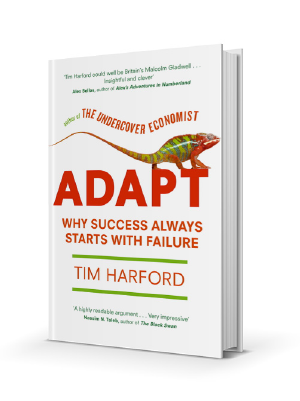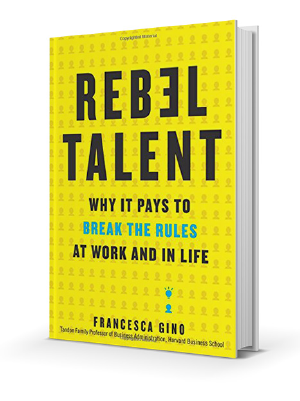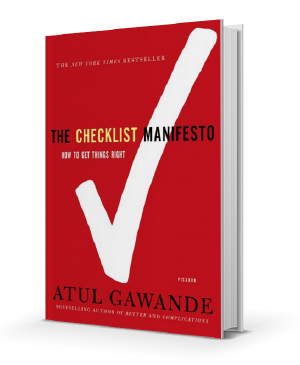Where once failure, the f-word, was the domain of losers, it’s now a cause célèbre, a hard-earned badge of redemption and authenticity.
In ads for sneakers, athletes relish in how many times they missed the winning shot, in magazine articles CEOs take pride in recounting their blunders, politicians and celebrities their lowest moments, even their disgraces. Business gurus tell us to “fail forward,” governments roll out programs to encourage acceptance of failure in entrepreneurship and colleges offer courses for new students on dealing with the fear of failure.
The benefits of failure shouldn’t be news to us. Toddlers develop into autonomous, well-functioning selves by testing boundaries. Fall over, pick yourself up, fall over with a little less pain the next time. It’s as basic and fundamental as evolution. Indeed, in his book Why Most Things Fail, theoretical economist Paul Ormerod argues that failure is the defining characteristic of successful biological, social, and economic systems; “99.99 percent of all species that have ever lived are now extinct. And, like species, most firms fail. On average, more than 10 percent of all companies in America disappear each year,” he says.

The wisdom of learning from failure is incontrovertible, and the benefits manifold. From preventing recurring mistakes, to spurring innovation, to helping you find your true course, to uncovering opportunities, it often begins with failure.
Yet for most of us mortals, this advice is still hard to take: failure is painful. Failure also involves some very real costs — it wastes money, destroys morale, infuriates customers, damages reputations, and can sometimes lead to legal trouble/malpractice suits. For small business owners, there is the very legitimate risk that a major failure — choosing a wrong location, for example – could be fatal.
Advertisement
Further, there’s a concern among many managers that encouraging failure presents a moral hazard, that a fear-no-failure culture will lead to an anything-goes environment among staff.
As a result, despite all the good talk about failure, most businesses continue to do the opposite. They punish mistakes, shoot the messenger bearing cautionary news, deny errors, blame others, make no systematic effort to study it and basically ignore whatever messages failure has to teach them.
And in doing so, they double down on their errant course of action, stifle risk taking and take a step toward creating the very thing they are trying to avoid — a terminal misstep.

Adapt: Why Success Always Starts With Failure by Tim Harford
As the business world becomes more complex and uncertain, the issue is becoming more critical. In 2019, leading a business is not so much about good management, as it is about how you respond to new threats, new trends, new technologies. Nobody gets it right the first time anymore.
“It’s not about effective planning. It’s about trial and error,” Tim Harford, a Financial Times columnist, writes in his book, Adapt: Why Success Always Starts With Failure. “Those who can afford to fail more times will succeed in the long run, he says echoing the famous quote of IBM’s Thomas Watson, Sr.: “The fastest way to succeed is to double your failure rate.”
Advertisement
Amy Edmondson, a professor in management at Harvard Business School, sees three kinds of failures: Intelligent or good failures (when we expect to fail and learn something), preventable or bad failures (when we’re sabotaged by errors in judgment or ineptitude), or unavoidable failures (when complex systems break down).
Intelligent failures are the easiest to deal with, at least from a psychological perspective, and there’s no shortage of Silicon Valley companies from Google to Intuit that have incorporated the exploration of such failures into their systems.
Learning to deal with “bad mistakes” seems the most straightforward. And the approach the most traditional: Use checklists, improve training, encourage feedback.
The third kind of mistake, the complex ones, are probably the most interesting because the situations in which they occur are increasing. The most effective approach involves giving into chance, expecting failure, and reacting flexibly, says Ormerod.
Small business owners will face all three kinds of failures and need to be able to recognize them.
In the following pages, we provide some tips to help you prepare for when things go wrong and to get the best out of situations when they do go awry.
Advertisement
The possibility of failure is what makes life worth living. When there is no challenge, the joy evaporates (try playing a video game designed for four-year-olds and see how long that stays fun!)
The poet Rainer Maria Rilke summed it up nicely: “The purpose of life is to be defeated by ever greater things.”
In business, those challenges are waiting every day. Go down valiantly.
27 Ways to Make the Most of Failure
Failing is an inevitability and the stink of it is hard to shake. But we’ve got 27 tips to help you navigate those foul-smelling waters.
Contain the Downside
1There is a key caveat underlying all failure literature, and that is to be able to enjoy the benefits, you’ve got to be able to survive the experience, thus the advice to fail small and cheaply. Always ask, “What is the minimum viable experiment?” says Roy H. Williams, a.k.a. the “Wizard of Ads.” It also helps to stick to “adjacencies,” or areas where you have some related business experience. The business world is littered with the dead projects of companies that strayed too far from their core competence. To be sure even a small failure can be expensive, but in the long run ignorance tends to be even more costly. “Generally, I don’t have much patience with people who worry about the waste and cost inherent in experimentation,” says Harford. “Look at the Soviet Union — what looks to be efficient rationalization is often a system that can’t learn or adapt.”
Debrief
2When a business venture fails, sure, it sucks. When a military expedition fails, people die. The life-or-death nature of that business explains the military’s relentless review system, known as “after-action reviews” (AARs) of each combat encounter and combat-training exercise. “As in business, the reasons for success or failure in combat often are not clear,” writes behavioral scientist Francesca Gino, author of Rebel Talent: Why It Pays To Break The Rules At Work And In Life. “AAR participants discuss four key questions: What did we set out to do? What actually happened? Why did it happen? What are we going to do next time?” To be sure, failure reviews aren’t much fun. Most people would rather sweep the little disaster under the carpet and look forward. But then the learning opportunity is lost. Such “reviews work best when they are fast and to the point; take place frequently, through good times and bad; and are forward-looking, with an emphasis on learning, not assigning blame, write Julian Birkinshaw and Martine Haas in Increase Your Return On Failure. “Some failures provide immediate value in the form of market insights that can be capitalized on. Others provide broader lessons that lead to significant personal or organizational development.”

Have Plan B, C and D Ready

Rebel Talent: Why It Pays To Break The Rules At Work And In Life by Francesca Gino
3“Expose yourself to lots of different ideas and try lots of different approaches on the grounds that failure is common,” says Tim Harford in his book Adapt: Why Success Always Starts With Failure. “This approach is far less intimidating than trying to come up with the best idea ever. You need Plan B, Plan C, Plan D. You need a full quiver of arrows.” Not only does a fallback position make it easier psychologically to be wrong, but it enables you to take away a wider range of lessons from each mistake, he says. Ideally, you want to try a mix of off-the-wall ideas and by-the-book practices.
Aim Low
4A common mistake even at big corporations is to test new products or services under optimal conditions, says Edmondson. Take the example of a new website rollout. Rather than assume visitors will be tech-savvy millennials, test the site with limited support, unsophisticated customers, and old computers or phones. Such tests would be designed to discover everything that could go wrong — instead of proving that under the best of conditions everything would go right. “Of course, the managers in charge would have to have understood that they were going to be rewarded not for success but, rather, for producing intelligent failures as quickly as possible,” she says.
Or, Don’t Even Fail at All
5Author Daniel Kahneman suggests something known as a “premortem.” Before launching an event, gather your team and tell them to imagine they are in the future looking at the aftermath of the event, which has flopped. Why? This removes pressure about seeming disloyal by being less than positive about the project and makes it easier to make changes that could save it.
Beware Your Biases
6The human capacity for self-deception is profound. It thus helps hugely to be aware of the kinds of biases that can undermine a proper evaluation of a project. Among the most common psychological blind spots related to failure are the “God complex” (feelings of infallibility), chasing your losses (taking bigger risks to win back lost money), or hedonic editing (when we try to convince ourselves that a mistake doesn’t matter, or finding some way to reinterpret our failures as successes). Few of us can make purely rational decisions. Beware of your biases.
Dig Deep
7When Edmondson discusses failure with executives she often asks them to consider her Spectrum of Reasons for Failure, which lists causes ranging from deliberate deviation to thoughtful experimentation. “When I ask executives to estimate how many of the failures in their organizations are truly blameworthy, their answers are usually in single digits — perhaps 2 percent to 5 percent. But when I ask how many are treated as blameworthy, they say (after a pause or a laugh) 70 to 90 percent. The unfortunate consequence is that many failures go unreported and their lessons are lost.” To be sure, managers need to make a distinction between excusable and inexcusable mistakes, but often by probing deeper there are underlying causes that are more important. Was the cause of an error carelessness, lack of training, fatigue or some other issue? Rick Rickgauer of Vision Associates in Girard, PA, recalls such an instance from earlier in his career: “A long time ago, when I worked at LensCrafters (when it was owned by US Shoe) in Tucson, they were opening a new store and hired two lab guys with a ton of experience. Suffice to say they crumbled under the one hour cookie. The lesson learned was this: hire people for the lab with absolutely no experience because they come in thinking that is the norm. They don’t know any better. The best lab people we ever had came in as bare-naked novices.” And even in those preventable instances involving “bad failures,” there is still a learning opportunity. As the line goes, good judgment comes from experience. Experience comes from bad judgment.

A Main Dish of Mea Culpa
8Look for opportunities to share your mistakes, be it at a lunch, an industry peer group or some other professional gathering. “If you’re having lunch with some of your peers, then revealing failure is a great strategy to induce levels of liking by reducing malicious envy,” Harvard’s Edmondson says. “When people share their experiences in an atmosphere of respect and mutual trust, a special kind of magic occurs: smart people become wise and their businesses begin to grow,” says Williams, who regularly brings together small businesspeople to study at his Texas retreat.
Keep a Failure Resume
9A failure résumé is a simple idea: When you fail, write it down. But instead of focusing on how that failure makes you feel, take the time to step back and analyze the practical, operational reasons that you failed. What’s the point of such self-flagellation, asks Tim Herrera in his Smarter Living column for the New York Times? “Because honestly analyzing one’s failures can lead to the type of introspection that helps us grow — as well as show that the path to success isn’t a straight line.” It can also be a reminder of how much you’ve tried, said Melanie Stefan at Edinburgh Medical School, who gave the idea some publicity when she called on fellow academics to publish their own “failure résumés” a few years ago.
Focus on the Process Not the Result
10According to Dan Ariely, author of the best seller Irrationally Predictable, organizations and humans as a whole tend to focus too much on the outcome rather than the process. “Sometimes the idea is very good but the outcome is negative.” If we want to encourage good ideas and people to try difficult things, then we need to emphasize systems over goals, and analysis over blame. Edmondson concurs: “The key is to insist on developing a clear understanding of what happened — not of “who did it”— when things go wrong. Farson and Keyes recommend eschewing both praise and blame. “Failure-tolerant leaders avoid giving either praise or criticism, preferring to take a nonjudgmental, analytical posture as they interact with staff. And they try to root out the destructive competitiveness built into most organizations,” they write.
Fail Differently Each Time
11A crucial question to ask yourself about your mis-hits, is, “Am I failing differently each time?” says Steven Levitt, author of the business bestseller Freakonomics. For all our talk here about failure, what we are actually talking about is learning. Fail the same way over and over and you’re clearly not learning.

Build a Culture that Celebrates “Intelligent Failure”
12As 3M’s legendary chairman William McKnight once said, “The best and hardest work is done in the spirit of adventure and challenge … Mistakes will be made.” A risk averse culture, on the other hand, is dangerous. Once you quit innovating and become guardians of the status quo the end is only a matter of time away. “One division head I worked with would say to his team members during their performance reviews, ‘Show me your scrap heap,’” recalls Wharton’s Gunther McGrath. “The request perfectly conveys the idea that high achievers will, of necessity, try some things that don’t work out.” Tom Peters sums it up another way: “Reward excellent failures. Punish mediocre successes.”
Fail From the Front

Whoever Makes The Most Mistakes Wins by Richard Farson and Ralph Keyes
13The example set by owners and management is crucial. Far from revealing weakness, admitting mistakes shows a leader’s self-confidence and helps forge closer ties with employees. “A blunder admitted is empathy earned,” write Richard Farson and Ralph Keyes in Whoever Makes The Most Mistakes Wins. “Leaders who don’t cover up their errors reveal themselves as human — they become people whom others can admire and identify with.” Adds Edmondson: “Only leaders can create and reinforce a culture that counteracts the blame game and makes people feel both comfortable with and responsible for surfacing (exposing) and learning from failures.”
Codify and Share What You Learn
14While it’s useful to reflect on individual failures, the real payoff comes when the lessons are spread across the organization or even better, they become part of institutional memory. At Coca-Cola, stories about the failure of New Coke are still told 30 years on. Former CEO Roberto Goizueta got years of one-liners from the fiasco. “Admitting his mistake conveyed to his employees better than a hundred speeches or a thousand memos that ‘learning failures,’ even on a grand scale, were tolerated,” says Farson.
Hail the Messenger of Bad News
15“The biggest mistake you can make as a leader is to shoot the messenger and bury the bad news,” write Birkinshaw and Haas. “Big, painful, expensive failures are easy to spot. But in many organizations any failure that can be hidden is hidden as long as it’s unlikely to cause immediate or obvious harm.” The goal should be to identify it early, before it has mushroomed into disaster. Among the ways to do this: creating a shared understanding around the types of failures that employees can expect; being accessible as a leader and rewarding the messenger who brings up bad news.
Use Symbolic Rituals
16Heroic Failure Awards, Failure Walls (a space in your back room where you and staff can share your “growth lessons”), or a Failure Hour (a weekly meeting devoted to things that went wrong and can be improved) can help create an environment in which failures are openly and seriously discussed. “Something magical happens to failure when it’s openly acknowledged,” writes business author Jeff Stibel in a column for Bizjournals.com. “Paradoxically, it becomes less of a big deal. The idea of failure is often the elephant in the room that no one wants to mention.”
Use Checklists

The Checklist Manifesto by Dr. Atul Gawande
17In his book The Checklist Manifesto, Dr. Atul Gawande argues that in our complex modern world, failure results not so much from ignorance (not knowing enough about what works) as from ineptitude (not properly applying what we know works). His solution — checklists. In medicine, a field where the available well of learning expands exponentially every year, the problem is “making sure we apply the knowledge we have consistently and correctly,” says Gawande. A recent study in UK hospitals suggested that wider use of checklists might prevent a staggering 40 percent of deaths during treatment. If surgeons can fill out checklists, the rest of us should probably be willing to run our expertise by the numbers as well.
Don’t Fret the Moral Hazard
18If people aren’t blamed for failures, what will ensure that they try as hard as possible to do their best work? What stops a business from descending into anything-goes chaos? According to Edmondson, such concerns are based on a false dichotomy: “In actuality, a culture that makes it safe to admit and report on failure can — and in some organizational contexts must — coexist with high standards for performance.” Encouraging failure doesn’t mean abandoning supervision, quality control, or respect for sound practices. In fact, it’s just the opposite, argue Farson and Keyes. “Managing for failure requires executives to be more engaged, not less. Astute managers mark the daily progress of small successes and failures with an evenhanded, open curiosity about the lessons learned and the next steps to take.”
Give Back the Pen
19It’s not just at the organizational level that failure can be “a gift.” Individuals, likely including your employees, can benefit from its didactic embrace. The problem is that many managers are what psychologists call “over-functioners” — faced with a challenge in the store, they spring into fixing mode, taking control, attacking the issue, offering instructions and dealing with it. As with raising kids, it often helps to let your underlings fail to allow them to develop, even if it creates some short-term anxiety or uncertainty. When a person is stuck or struggling, ask them “What do you think you should do? Go try it and I’ll give you some ideas and then you see how it goes.”

Be Unorthodox
20The pioneering behavioral psychologist Daniel Kahneman changed the standard view that humans are rational economic actors. The Soviet Union proved something similar for economies — what looks to be efficient rationalization is often a system that can’t learn or adapt. It’s the same for just about any business. British advertising great David Ogilvy had an interesting take on this: “The beginning of greatness is to be different. And the beginning of failure is to be orthodox. Big ideas come from the unconscious. This is true in art, in science, and in advertising. But your unconscious has to be well informed, or your idea will be irrelevant. Stuff your conscious mind with information, then unhook your rational thought process.” Go expose yourself to ideas and experiences.
Revisit and Reboot
21Jennifer Leuzzi, owner of Mill Creek Optical in Dansville, NY, says she felt like a failure when she changed locations after 20 years and built out an exam room for the express purpose of enlisting a doctor to perform exams. “I thought I could find a doctor to just zip in a few days a week to give exams,” she says. “I invested in some ‘gently used’ equipment and it ended up sitting there collecting dust. Turns out I would’ve never been able to handle more Rx’s. The move did prove to increase my business enough to keep me VERY busy! I’m going to donate the equipment.” It’s an important lesson that failure is sometimes a matter of perspective. Ed Boyden, an MIT neuroscientist and popular TED talker, says “Many of the projects that we do that appear quite successful, it’s actually often the second or third time we’ve given it a try.”
You are Not Your Failures
22A lot of us look to athletes for inspiration, especially when it comes to taking on a daunting challenge. But according to British sports psychologist James Hamilton, many elite athletes have a pretty unhealthy view of success and failure, associating defeat with an all-round failure of the self. To be sure, it can fuel a heightened drive, leading them to put up with huge levels of discomfort and deprivation, but it can also result in risk-avoidance and self-blame when things don’t pan out as they had hoped. A much healthier view, he says, is to remember that any failure “stands separate” from you. That if you fail, the failure happened, but you don’t become “a failure” he writes in The Guardian.
From the Start, Know What Failure Looks Like
23Recognizing failure can be surprisingly difficult. We’ve been trained that “persistence pays off,” so it feels wrong to cut our losses and label an idea a failure. “Decide what success and failure would look like before you launch an initiative,” says Wharton Business School’s Rita Gunther McGrath, noting that some big corporations build exit strategies into their projects to ensure that doomed or resource-sucking efforts do not drag on. “Being able to recognize a failure just means that you’ll be able to re-cast it into something more likely to succeed,” adds Harford. In such instances, feedback — either in the form of data or third-party reviews — is essential for determining which experiments have succeeded and which have failed. “Get advice, not just from one person, but from several,” he says.
Don’t Let Fear Have the Casting Vote
24A big part of dealing with the issue of failures has to do with fear, fear of messing up in the future or fear of losing something that we’d gained in the past. In her latest book Big Magic, Elizabeth Gilbert notes that fear can be a sign that something is important to you. The trick, if you can do it, isn’t to ignore fear, or try to conquer it, and definitely not to obey it, but to treat it like an annoying younger sibling and make space for it. She uses the analogy of a road trip. “Fear always comes along for the ride, and that’s fine — but that doesn’t mean you need to let it anywhere near the steering wheel.”
Get Comfortable with Rags – It’s Not So Bad
25Alternatively, try gaining serenity by actively confronting the experience of failure as Seneca — the Stoic philosopher much admired in current self-help literature — advised: “Set aside a certain number of days, during which you shall be content with the scantiest and cheapest fare, with coarse and rough dress, saying to yourself the while: ‘Is this the condition that I feared?’”
If it Ain’t Broke, Experiment
26There’s a view that success doesn’t have much to teach you — you may have been lucky, it will cover up mistakes, it saps the will to innovate, it can make you overconfident and misattribute the real factors at play. But it doesn’t have to be that way, say Francesca Gino and Gary Pisano in an article in the Harvard Business Review (“Why Leaders Don’t Learn from Success”). “Celebrate success but examine. Ironically, casting a critical eye on your success can better prepare you to avoid failure,” they write. Gino and Pisano say the right question for leaders of learning organizations to ask is not “What are we doing well?” but rather “What experiments are we running?” Keep looking at data even when things are going well — understanding why you’re successful is as important as understanding what causes mistakes.

Find a Podcast
27When things aren’t going well, there’s a fabulous world of inspiration out there — podcasts, TED talks, no end, really, of great people who have experienced what you’re going through and can provide a pick-me-up or reassurance or even tactical guidance. Designer Ida C. Benedetto told the Creative Independent she keeps a collection of such talks on her website — you can find them here: invisionmag.com/041901.